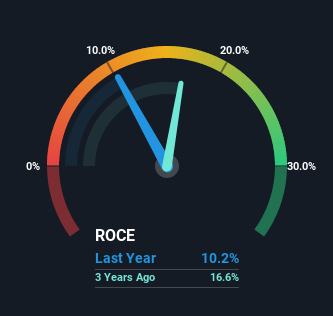If you're looking for a multi-bagger, there's a few things to keep an eye out for. Amongst other things, we'll want to see two things; firstly, a growing return on capital employed (ROCE) and secondly, an expansion in the company's amount of capital employed. Ultimately, this demonstrates that it's a business that is reinvesting profits at increasing rates of return. So, when we ran our eye over RHI Magnesita's (LON:RHIM) trend of ROCE, we liked what we saw.
What Is Return On Capital Employed (ROCE)?
For those who don't know, ROCE is a measure of a company's yearly pre-tax profit (its return), relative to the capital employed in the business. The formula for this calculation on RHI Magnesita is:
Return on Capital Employed = Earnings Before Interest and Tax (EBIT) ÷ (Total Assets - Current Liabilities)
0.10 = €298m ÷ (€4.1b - €1.2b) (Based on the trailing twelve months to June 2022).
Thus, RHI Magnesita has an ROCE of 10%. That's a relatively normal return on capital, and it's around the 11% generated by the Basic Materials industry.
Our analysis indicates that RHIM is potentially undervalued!

Above you can see how the current ROCE for RHI Magnesita compares to its prior returns on capital, but there's only so much you can tell from the past. If you're interested, you can view the analysts predictions in our free report on analyst forecasts for the company.
The Trend Of ROCE
While the returns on capital are good, they haven't moved much. The company has consistently earned 10% for the last five years, and the capital employed within the business has risen 139% in that time. Since 10% is a moderate ROCE though, it's good to see a business can continue to reinvest at these decent rates of return. Stable returns in this ballpark can be unexciting, but if they can be maintained over the long run, they often provide nice rewards to shareholders.
The Key Takeaway
The main thing to remember is that RHI Magnesita has proven its ability to continually reinvest at respectable rates of return. Yet over the last five years the stock has declined 39%, so the decline might provide an opening. For that reason, savvy investors might want to look further into this company in case it's a prime investment.
On a final note, we found 3 warning signs for RHI Magnesita (2 are potentially serious) you should be aware of.
While RHI Magnesita isn't earning the highest return, check out this free list of companies that are earning high returns on equity with solid balance sheets.
New: AI Stock Screener & Alerts
Our new AI Stock Screener scans the market every day to uncover opportunities.
• Dividend Powerhouses (3%+ Yield)
• Undervalued Small Caps with Insider Buying
• High growth Tech and AI Companies
Or build your own from over 50 metrics.
Have feedback on this article? Concerned about the content? Get in touch with us directly. Alternatively, email editorial-team (at) simplywallst.com.
This article by Simply Wall St is general in nature. We provide commentary based on historical data and analyst forecasts only using an unbiased methodology and our articles are not intended to be financial advice. It does not constitute a recommendation to buy or sell any stock, and does not take account of your objectives, or your financial situation. We aim to bring you long-term focused analysis driven by fundamental data. Note that our analysis may not factor in the latest price-sensitive company announcements or qualitative material. Simply Wall St has no position in any stocks mentioned.
About LSE:RHIM
RHI Magnesita
Develops, produces, sells, installs, and maintains refractory products and systems used in industrial high-temperature processes worldwide.
Slight risk and fair value.
Similar Companies
Market Insights
Community Narratives



